microsoft dp-500 practice test
Designing and Implementing Enterprise-Scale Analytics Solutions Using Microsoft Azure and Microsoft Power BI
Question 1
You are using DAX Studio to analyze a slow-running report query.
You need to identify inefficient join operations in the query.
What should you review?
- A. the query statistics
- B. the query plan
- C. the query history
Answer:
b
Question 2
You have a Power BI workspace named Workspace1 that contains five dataflows.
You need to configure Workspace1 to store the dataflows in an Azure Data Lake Storage Gen2 account.
What should you do first?
- A. From the Power BI Admin portal, enable tenant-level storage.
- B. Disable load for all dataflow queries.
- C. Delete the dataflow queries.
- D. Change the Data source settings in the dataflow queries.
Answer:
a
Question 3
DRAG DROP This is a case study. Case studies are not timed separately. You can use as much exam time as you would like to complete each case. However, there may be additional case studies and sections on this exam. You must manage your time to ensure that you are able to complete all questions included on this exam in the time provided.
To answer the questions included in a case study, you will need to reference information that is provided in the case study. Case studies might contain exhibits and other resources that provide more information about the scenario that is described in the case study. Each question is independent of the other questions in this case study.
At the end of this case study, a review screen will appear. This screen allows you to review your answers and to make changes before you move to the next section of the exam. After you begin a new section, you cannot return to this section.
To start the case study To display the first question in this case study, click the Next button. Use the buttons in the left pane to explore the content of the case study before you answer the questions. Clicking these buttons displays information such as business requirements, existing environment, and problem statements. If the case study has an All Information tab, note that the information displayed is identical to the information displayed on the subsequent tabs. When you are ready to answer a question, click the Question button to return to the question.
Overview
Existing environment Litware, Inc. is a retail company that sells outdoor recreational goods and accessories. The company sells goods both online and its stores located in six countries.
Azure Resources Litware has the following Azure resources:
An Azure Synapse Analytics workspace named synapseworkspace1
An Azure Data Lake Storage Gen2 account named datalake1 that is associated with synapseworkspace1
A Synapse Analytics dedicated SQL pool named SQLDW
Dedicated SQL Pool SQLDW contains a dimensional model that contains the following tables.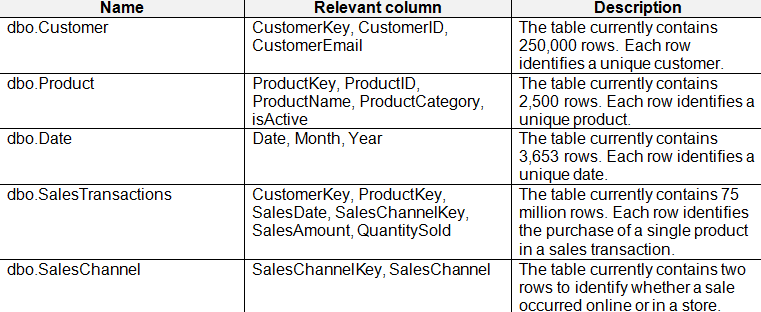
SQLDW contains the following additional tables.
SQLDW contains a view named dbo.CustomerPurchases that creates a distinct list of values from dbo.Customer [customerID], dbo.Customer [CustomerEmail], dbo.Product [ProductID] and dbo.Product [ProductName].
The sales data in SQLDW is updated every 30 minutes. Records in dbo.SalesTransactions are updated in SQLDW up to three days after being created. The records do NOT change after three days.
Power BI Litware has a new Power BI tenant that contains an empty workspace named Sales Analytics.
All users have Power BI Premium per user licenses.
IT data analytics are workspace administrators. The IT data analysts will create datasets and reports.
A single imported dataset will be created to support the companys sales analytics goals. The dataset will be refreshed every 30 minutes.
Requirements
Analytics Goals Litware identifies the following analytics goals:
Provide historical reporting of sales by product and channel over time.
Allow sales managers to perform ad hoc sales reporting with minimal effort.
Perform market basket analysis to understand which products are commonly purchased in the same transaction.
Identify which customers should receive promotional emails based on their likelihood of purchasing promoted products.
Litware plans to monitor the adoption of Power BI reports over time. The company wants custom Power BI usage reporting that includes the percent change of users that view reports in the Sales Analytics workspace each month.
Security Requirements Litware identifies the following security requirements for the analytics environment:
All the users in the sales department and the marketing department must be able to see Power BI reports that contain market basket analysis and data about which customers are likely to purchase a product.
Customer contact data in SQLDW and the Power BI dataset must be labeled as Sensitive. Records must be kept of any users that use the sensitive data.
Sales associates must be prevented from seeing the CustomerEmail column in Power BI reports.
Sales managers must be prevented from modifying reports created by other users.
Development Process Requirements
Litware identifies the following development process requirements:
SQLDW and datalake1 will act as the development environment. Once feature development is complete, all entities in synapseworkspace1 will be promoted to a test workspace, and then to a production workspace.
Power BI content must be deployed to test and production by using deployment pipelines.
All SQL scripts must be stored in Azure Repos.
The IT data analysts prefer to build Power BI reports in Synapse Studio.
You need to implement object-level security (OLS) in the Power BI dataset for the sales associates.
Which three actions should you perform in sequence? To answer, move the appropriate actions from the list of actions to the answer area and arrange them in the correct order.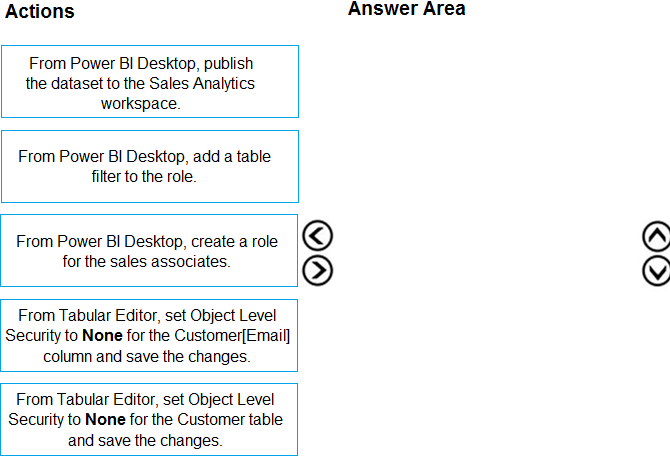
Answer:
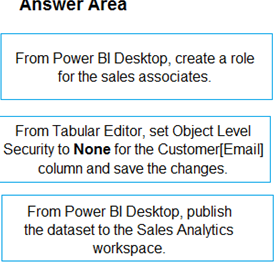

Question 4
Note: This question is part of a series of questions that present the same scenario. Each question in the series contains a unique solution that might meet the stated goals. Some question sets might have more than one correct solution, while others might not have a correct solution.
After you answer a question in this question, you will NOT be able to return to it. As a result, these questions will not appear in the review screen.
You have the Power BI data model shown in the exhibit. (Click the Exhibit tab.)
Users indicate that when they build reports from the data model, the reports take a long time to load.
You need to recommend a solution to reduce the load times of the reports.
Solution: You recommend denormalizing the data model.
Does this meet the goal?
- A. Yes
- B. No
Answer:
a
Question 5
You develop a solution that uses a Power BI Premium capacity. The capacity contains a dataset that is expected to consume 50 GB of memory.
Which two actions should you perform to ensure that you can publish the model successfully to the Power BI service? Each correct answer presents part of the solution.
NOTE: Each correct selection is worth one point.
- A. Restart the capacity.
- B. Publish an initial dataset that is less than 10 GB.
- C. Increase the Max Offline Dataset Size setting.
- D. Invoke a refresh to load historical data based on the incremental refresh policy.
- E. Publish the complete dataset.
Answer:
de
Question 6
Note: This question is part of a series of questions that present the same scenario. Each question in the series contains a unique solution that might meet the stated goals. Some question sets might have more than one correct solution, while others might not have a correct solution.
After you answer a question in this question, you will NOT be able to return to it. As a result, these questions will not appear in the review screen.
You are using an Azure Synapse Analytics serverless SQL pool to query a collection of Apache Parquet files by using automatic schema inference. The files contain more than 40 million rows of UTF-8-encoded business names, survey names, and participant counts. The database is configured to use the default collation.
The queries use OPENROWSET and infer the schema shown in the following table.
You need to recommend changes to the queries to reduce I/O reads and tempdb usage.
Solution: You recommend defining an external table for the Parquet files and updating the query to use the table.
Does this meet the goal?
- A. Yes
- B. No
Answer:
b
Question 7
DRAG DROP This is a case study. Case studies are not timed separately. You can use as much exam time as you would like to complete each case. However, there may be additional case studies and sections on this exam. You must manage your time to ensure that you are able to complete all questions included on this exam in the time provided.
To answer the questions included in a case study, you will need to reference information that is provided in the case study. Case studies might contain exhibits and other resources that provide more information about the scenario that is described in the case study. Each question is independent of the other questions in this case study.
At the end of this case study, a review screen will appear. This screen allows you to review your answers and to make changes before you move to the next section of the exam. After you begin a new section, you cannot return to this section.
To start the case study To display the first question in this case study, click the Next button. Use the buttons in the left pane to explore the content of the case study before you answer the questions. Clicking these buttons displays information such as business requirements, existing environment, and problem statements. If the case study has an All Information tab, note that the information displayed is identical to the information displayed on the subsequent tabs. When you are ready to answer a question, click the Question button to return to the question.
Overview Contoso, Ltd. is a company that sells enriched financial data to a variety of external customers.
Contoso has a main office in Los Angeles and two branch offices in New York and Seattle.
Existing Environment
Data Infrastructure Contoso has a 50-TB data warehouse that uses an instance of SQL Server on Azure Virtual Machines.
The data warehouse populates an Azure Synapse Analytics workspace that is accessed by the external customers. Currently, the customers can access all the data.
Contoso has one Power BI workspace named FinData that contains a single dataset. The dataset contains financial data from around the world. The workspace is used by 10 internal users and one external customer. The dataset has the following two data sources: the data warehouse and the Synapse Analytics serverless SQL pool.
Users frequently query the Synapse Analytics workspace by using Transact-SQL.
User Problems Contoso identifies the following user issues:
Some users indicate that the visuals in Power BI reports are slow to render when making filter selections.
Users indicate that queries against the serverless SQL pool fail occasionally because the size of tempdb has been exceeded.
Users indicate that the data in Power BI reports is stale. You discover that the refresh process of the Power BI model occasionally times out.
Planned Changes Contoso plans to implement the following changes:
Into the existing Power BI dataset, integrate an external data source in JSON that is accessible by using the REST API.
Build a new dataset in the FinData workspace by using data from the Synapse Analytics dedicated SQL pool.
Provide all the customers with their own Power BI workspace to create their own reports. Each workspace will use the new dataset in the FinData workspace.
Implement subscription levels for the customers. Each subscription level will provide access to specific rows of financial data.
Deploy prebuilt datasets to Power BI to simplify the query experience of the customers.
Provide internal users with the ability to incorporate machine learning models loaded to the dedicated SQL pool.
You need to integrate the external data source to support the planned changes.
Which three actions should you perform in sequence? To answer, move the appropriate actions from the list of actions to the answer area and arrange them in the correct order.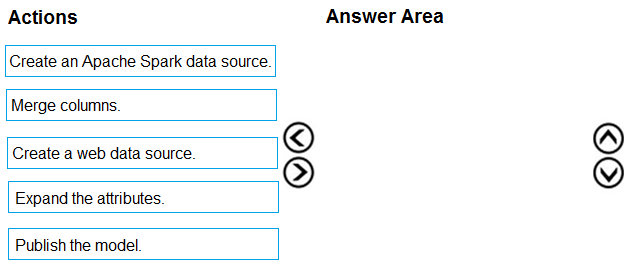
Answer:


Question 8
This is a case study. Case studies are not timed separately. You can use as much exam time as you would like to complete each case. However, there may be additional case studies and sections on this exam. You must manage your time to ensure that you are able to complete all questions included on this exam in the time provided.
To answer the questions included in a case study, you will need to reference information that is provided in the case study. Case studies might contain exhibits and other resources that provide more information about the scenario that is described in the case study. Each question is independent of the other questions in this case study.
At the end of this case study, a review screen will appear. This screen allows you to review your answers and to make changes before you move to the next section of the exam. After you begin a new section, you cannot return to this section.
To start the case study To display the first question in this case study, click the Next button. Use the buttons in the left pane to explore the content of the case study before you answer the questions. Clicking these buttons displays information such as business requirements, existing environment, and problem statements. If the case study has an All Information tab, note that the information displayed is identical to the information displayed on the subsequent tabs. When you are ready to answer a question, click the Question button to return to the question.
Overview
Existing environment Litware, Inc. is a retail company that sells outdoor recreational goods and accessories. The company sells goods both online and its stores located in six countries.
Azure Resources Litware has the following Azure resources:
An Azure Synapse Analytics workspace named synapseworkspace1
An Azure Data Lake Storage Gen2 account named datalake1 that is associated with synapseworkspace1
A Synapse Analytics dedicated SQL pool named SQLDW
Dedicated SQL Pool SQLDW contains a dimensional model that contains the following tables.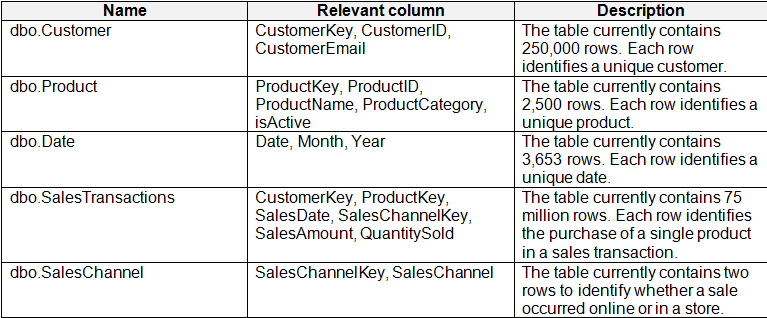
SQLDW contains the following additional tables.
SQLDW contains a view named dbo.CustomerPurchases that creates a distinct list of values from dbo.Customer [customerID], dbo.Customer [CustomerEmail], dbo.Product [ProductID] and dbo.Product [ProductName].
The sales data in SQLDW is updated every 30 minutes. Records in dbo.SalesTransactions are updated in SQLDW up to three days after being created. The records do NOT change after three days.
Power BI Litware has a new Power BI tenant that contains an empty workspace named Sales Analytics.
All users have Power BI Premium per user licenses.
IT data analytics are workspace administrators. The IT data analysts will create datasets and reports.
A single imported dataset will be created to support the companys sales analytics goals. The dataset will be refreshed every 30 minutes.
Requirements
Analytics Goals Litware identifies the following analytics goals:
Provide historical reporting of sales by product and channel over time.
Allow sales managers to perform ad hoc sales reporting with minimal effort.
Perform market basket analysis to understand which products are commonly purchased in the same transaction.
Identify which customers should receive promotional emails based on their likelihood of purchasing promoted products.
Litware plans to monitor the adoption of Power BI reports over time. The company wants custom Power BI usage reporting that includes the percent change of users that view reports in the Sales Analytics workspace each month.
Security Requirements Litware identifies the following security requirements for the analytics environment:
All the users in the sales department and the marketing department must be able to see Power BI reports that contain market basket analysis and data about which customers are likely to purchase a product.
Customer contact data in SQLDW and the Power BI dataset must be labeled as Sensitive. Records must be kept of any users that use the sensitive data.
Sales associates must be prevented from seeing the CustomerEmail column in Power BI reports.
Sales managers must be prevented from modifying reports created by other users.
Development Process Requirements
Litware identifies the following development process requirements:
SQLDW and datalake1 will act as the development environment. Once feature development is complete, all entities in synapseworkspace1 will be promoted to a test workspace, and then to a production workspace.
Power BI content must be deployed to test and production by using deployment pipelines.
All SQL scripts must be stored in Azure Repos.
The IT data analysts prefer to build Power BI reports in Synapse Studio.
How should you configure the Power BI dataset refresh for the dbo.SalesTransactions table?
- A. an incremental refresh of Product where the ModifiedDate value is during the last three days.
- B. an incremental refresh of dbo.SalesTransactions where the SalesDate value is during the last three days.
- C. a full refresh of all the tables
- D. an incremental refresh of dbo.SalesTransactions where the SalesDate value is during the last hour.
Answer:
b
Question 9
DRAG DROP You have a Power BI dataset. The dataset contains data that is updated frequently.
You need to improve the performance of the dataset by using incremental refreshes.
Which four actions should you perform in sequence to enable the incremental refreshes? To answer, move the appropriate actions from the list of actions to the answer area and arrange them in the correct order.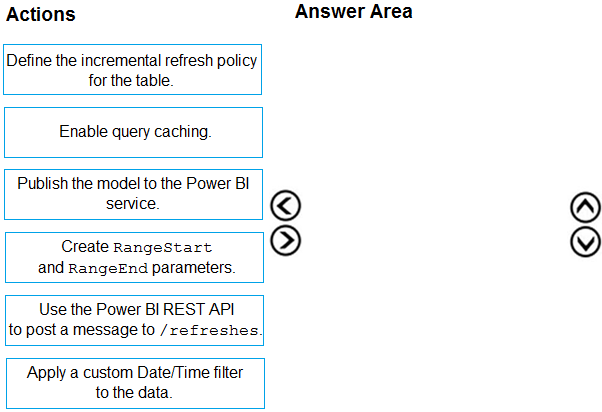
Answer:
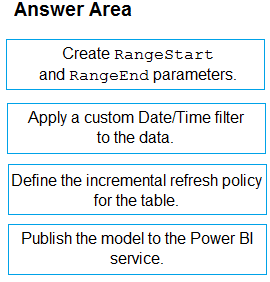

Question 10
HOTSPOT You are configuring an aggregation table as shown in the following exhibit.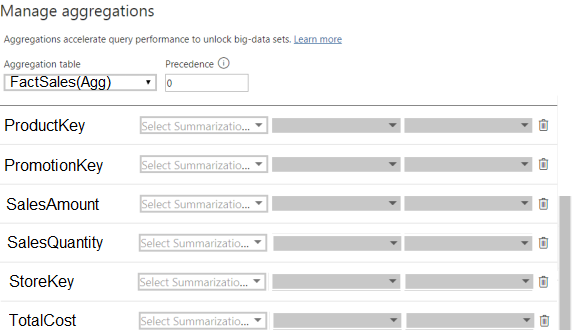
The detail table is named FactSales and the aggregation table is named FactSales(Agg).
You need to aggregate SalesAmount for each store.
Which type of summarization should you use for SalesAmount and StoreKey? To answer, select the appropriate options in the answer area.
NOTE: Each correct selection is worth one point.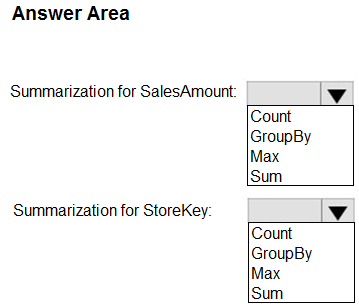
Answer:

